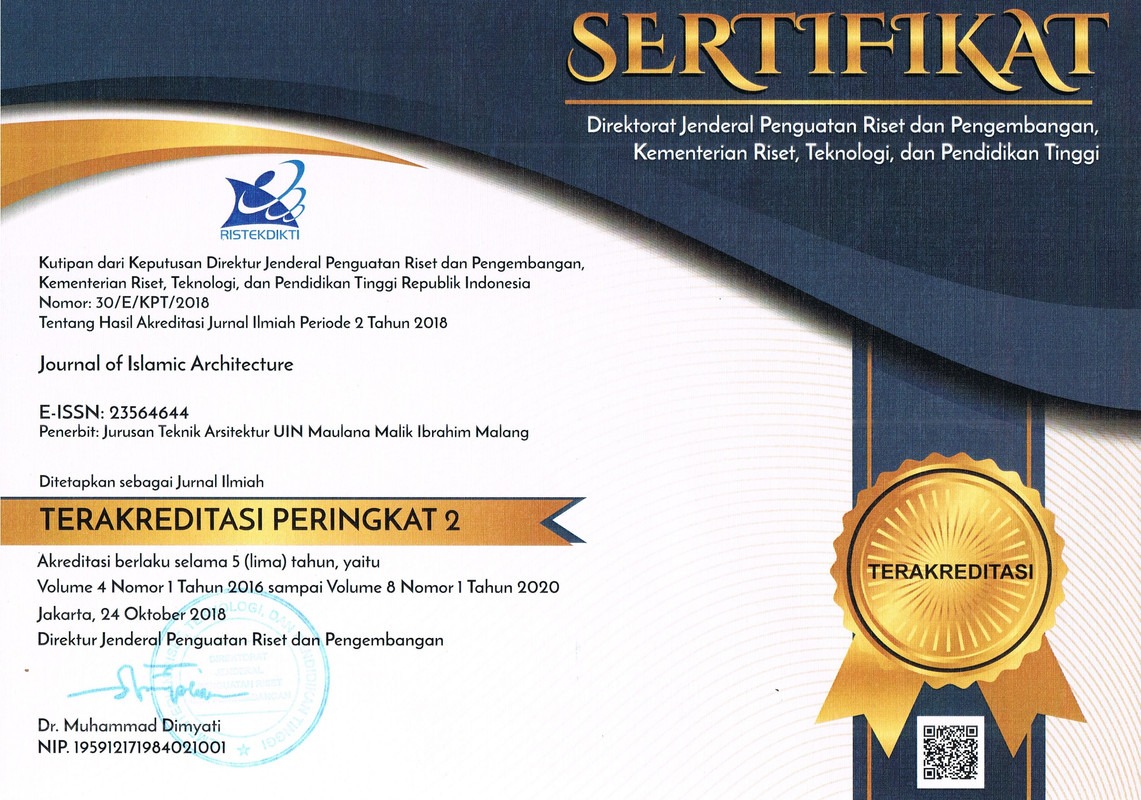"Mosque Architecture” Or Architecture of Mosque: A New Notions of Bengal During the Muslim Rule
Abstract
Keywords
Full Text:
PDFReferences
A. H. Dani, Muslim Architecture in Bengal, Dacca (Bangladesh). Pakistan: Asiatic Society of Pakistan, 1961.
D. S. M. Hasan, Dacca the City Of Mosques, Dacca (Bangladesh). bangladesh: Islamic Foundation Bangladesh, 1981.
A. T. M. Shamsuzzoha and H. Islam, “Structure, Decoration and Materials: Mughal Mosques of Medieval Dhaka,” J. Bangladesh Assoc. Young Res., vol. 1, no. 1, pp. 93–107, 2011.
A. Petersen, Dictionary of Islamic Architecture. London and New York: Routledge, 1996.
A. H. Dani, Muslim Architecture in Bengal, Dacca. Pakistan: Asiatic Society of Pakistan, 1961.
“No Title.” [Online]. Available: www.shrimpnews.com. [Accessed: 05-Nov-2015].
“Geocurrents,” 2015. [Online]. Available: http://www.geocurrents.info/. [Accessed: 27-Nov-2015].
Ahmad Hasan Dani, Muslim Architecture in Bengal, Dacca. Pakistan: Asiatic Society of Pakistan, 1961.
Dacca the City Of Mosques. op. cit., p. i.
J. D. M. (ed), “Encyclopedia Of The Quran,” Encycl. Quran, vol. vol -3, pp. 426–428., 2003.
Muslim Architecture in Bengal. op. cit, P.9.
A. N. Khan, Islamic Architecture in South Asia: Pakistan –India –Bangladesh. New York: Oxford University press, 2003.
A. N. Khan, Islamic Architecture in South Asia: Pakistan –India –Bangladesh,. New York: Oxford University press, 2003.
Dacca The City Of Mosques. Cit, Op.
S. E. H. (ed) Ishrat Alam, A Varied Facets Of History: Essay In Honor Of Aniruddha Ray. Dehli: Primus Books, 2011.
Muhammad Mohar Ali, History Of The Muslims Of Bengal. Riyadh: Imam Muhammad Ibn Sa‘ūd Islamic University, 1985.
Dictionary of Islamic Architecture. op. cit.
A. Ansari, A complete Book on Mughal Architecture History. New Dehli: Cyber Tech Publications, 2010.
A complete Book on Mughal Architecture History. New Dehli: Cyber Tech Publications, 2010.
“No Title.” [Online]. Available: http://www.westbengaltourism.gov.in/. [Accessed: 27-Nov-2015].
“Columbia University,” 2015. [Online]. Available: http://www.columbia.edu/. [Accessed: 27-Nov-2015].
“Himal,” 2015. [Online]. Available: http://old.himalmag.com/. [Accessed: 27-Nov-2015].
J. M. B. and S. S. Blair(ed), The Grave Encyclopedia Of Islamic Art And Architecture. New York: Oxford University Press, 2009.
“Famous Mosques in India.” [Online]. Available: http://www.indiamapped.com/mosques-in-india/. [Accessed: 05-Feb-2016].
“Wikipedia.” [Online]. Available: en.wikipedia.org. [Accessed: 27-Nov-2015].
“World for Travel.” [Online]. Available: http://www.worldfortravel.com/. [Accessed: 27-Nov-2015].
Architecture In South Asia. op. cit.
Wikipedia, “Mosque City of Bagerhat,” 2016. [Online]. Available: https://en.wikipedia.org/wiki/Mosque_City_of_Bagerhat. [Accessed: 05-Feb-2016].
“Panoramio.” [Online]. Available: http://www.panoramio.com/. [Accessed: 27-Nov-2015].
Wikipedia, “Binat Bibi Mosque,” 2016. [Online]. Available: https://en.wikipedia.org/wiki/Binat_Bibi_Mosque. [Accessed: 05-Feb-2016].
Islamic Architecture In South Asia. op. cit.
“Munshiganj: Baba Adam Mosque,” Lonely Traveler, 2010. [Online]. Available: http://icwow.blogspot.co.id/2010/06/munshiganj-baba-adam-mosque.html. [Accessed: 05-Feb-2016].
“No Title.” [Online]. Available: www.flickr.com. [Accessed: 27-Nov-2015].
“Picturestats.” [Online]. Available: https://picturestats.wordpress.com/. [Accessed: 27-Nov-2015].
“The History Hub.” [Online]. Available: http://www.thehistoryhub.com/. [Accessed: 27-Nov-2015].
Wikipedia, “Choto Sona Mosque,” 2016. [Online]. Available: https://en.wikipedia.org/wiki/Choto_Sona_Mosque. [Accessed: 05-Feb-2015].
“No Title.” [Online]. Available: commons.wikimedia.org. [Accessed: 27-Nov-2015].
Dacca the City of Mosques. op. cit.
“Offroad to Bangladesh.” [Online]. Available: http://offroadbangladesh.com/. [Accessed: 27-Nov-2015].
“Flickriver.” [Online]. Available: http://www.flickriver.com/. [Accessed: 27-Nov-2015].
C. T. Catherine B. Asher, India before Europe. UK: Cambridge University Press, 2006.
Wikipedia, “Katra Masjid,” 2016. [Online]. Available: https://en.wikipedia.org/wiki/Katra_Masjid. [Accessed: 05-Feb-2015].
S. Hasan and T. Corresponding, “The Contextual Issues in the Islamic Architecture of Bengal Mosques,” vol. 3, no. 1, pp. 41–48, 2013.
S. M. Hasan, Glimpses of Muslim Art and Architecture. Dacca (Bangladesh): Islamic Foundation, 1983.
P. Hasan, Sultanate Mosques and Continuity in Bengal Architecture. .
DOI: https://doi.org/10.18860/jia.v4i1.3167
Refbacks
- There are currently no refbacks.






